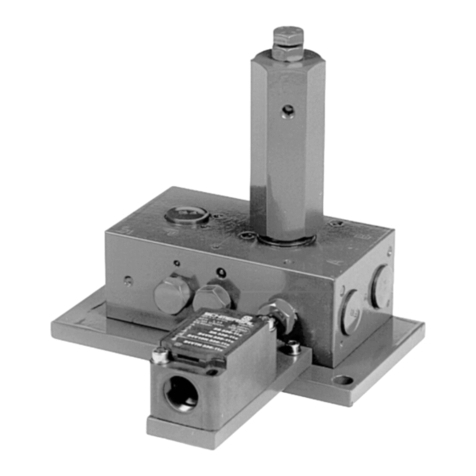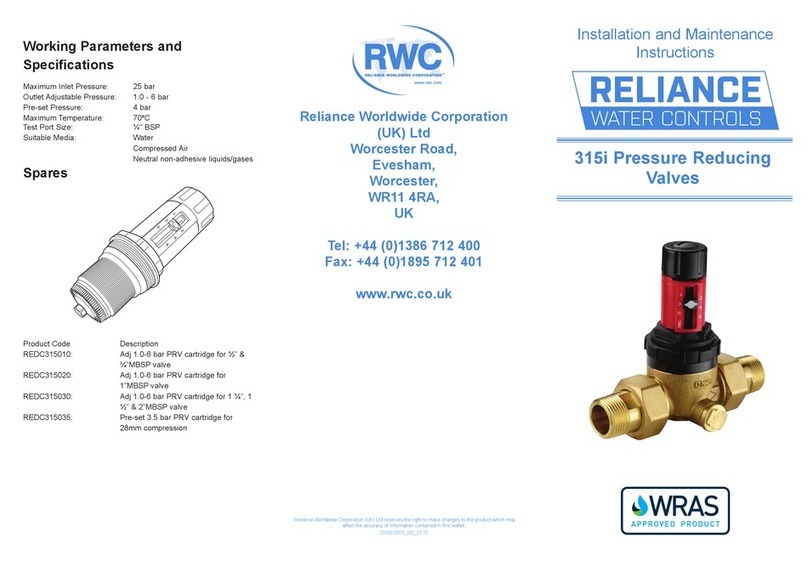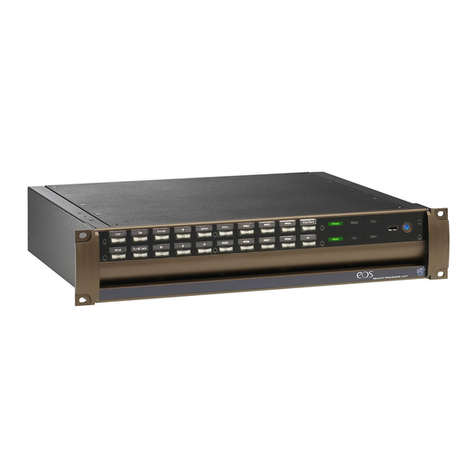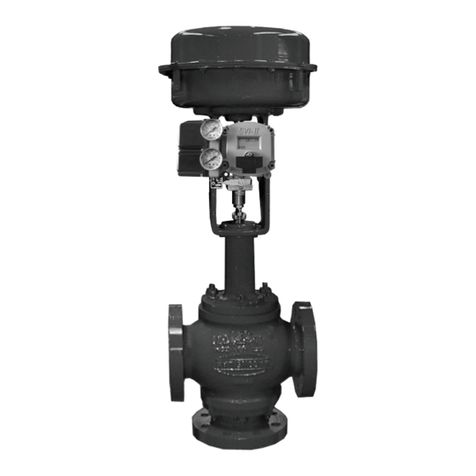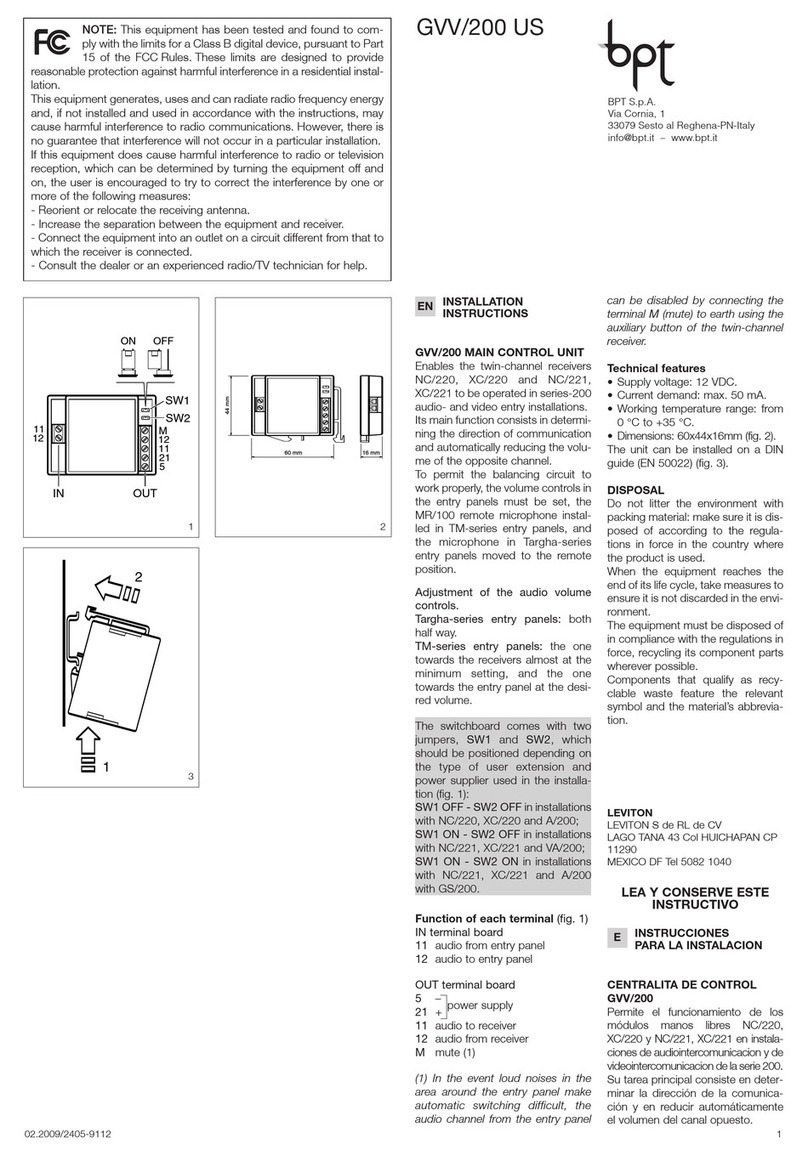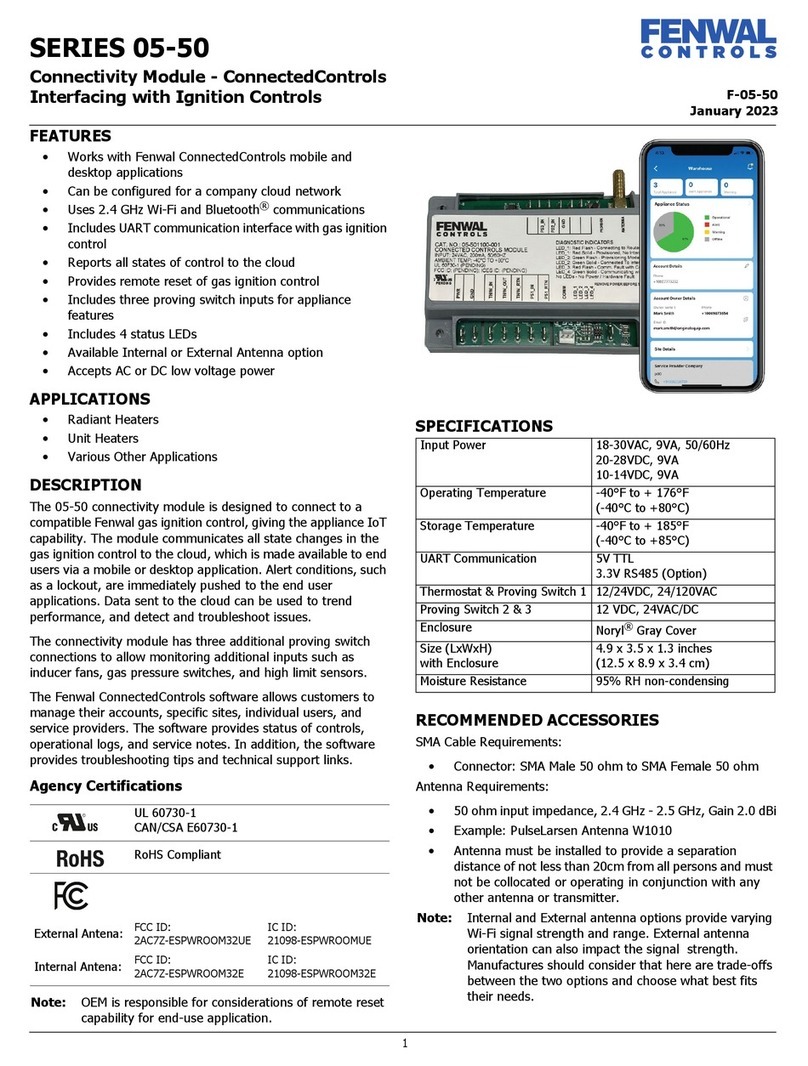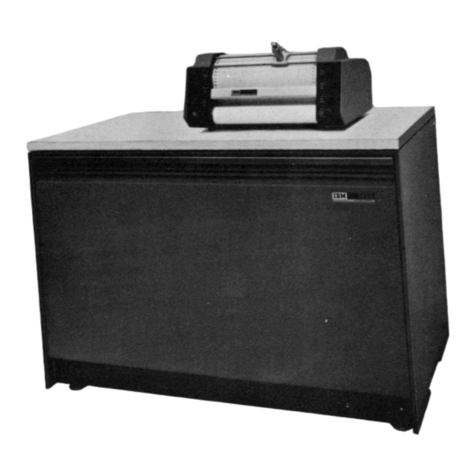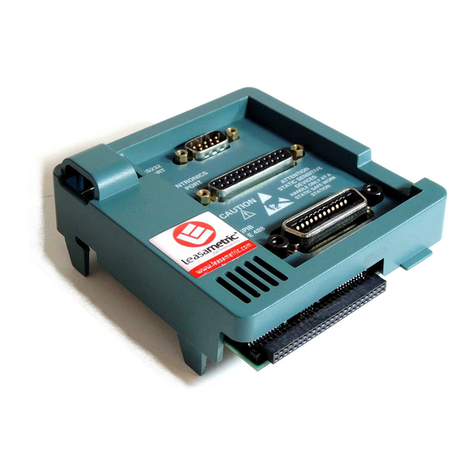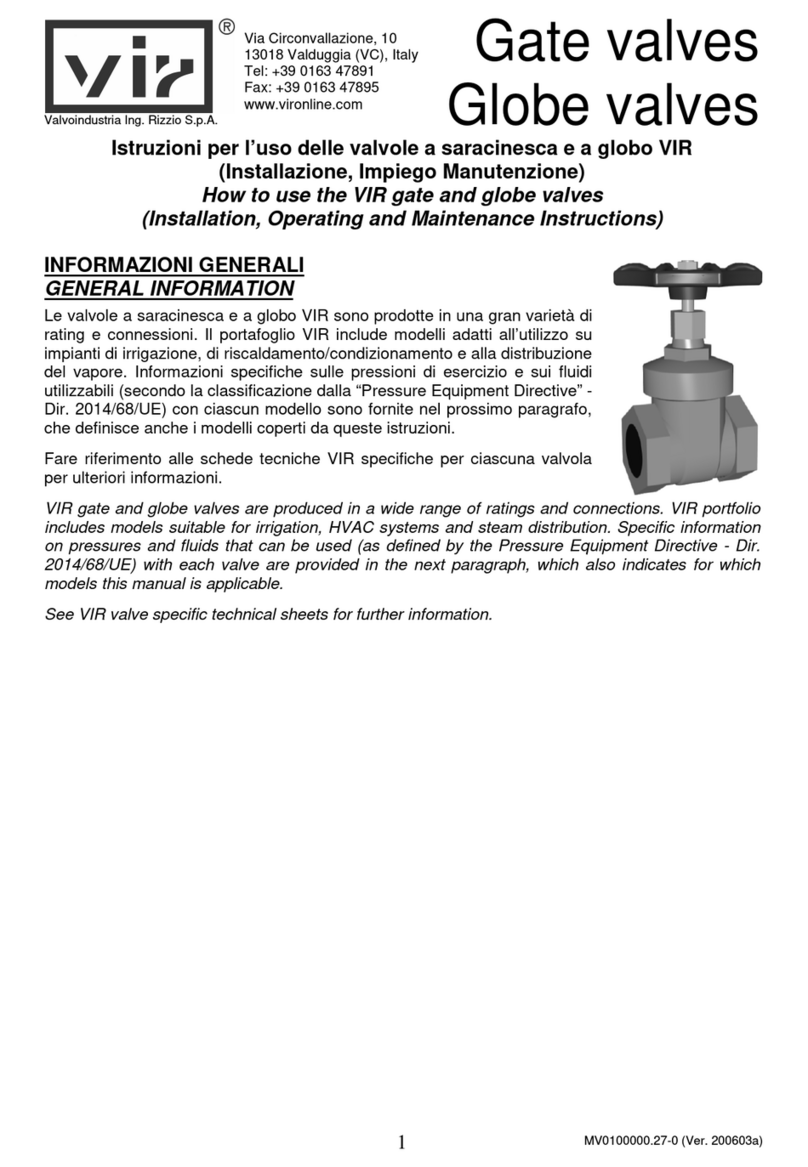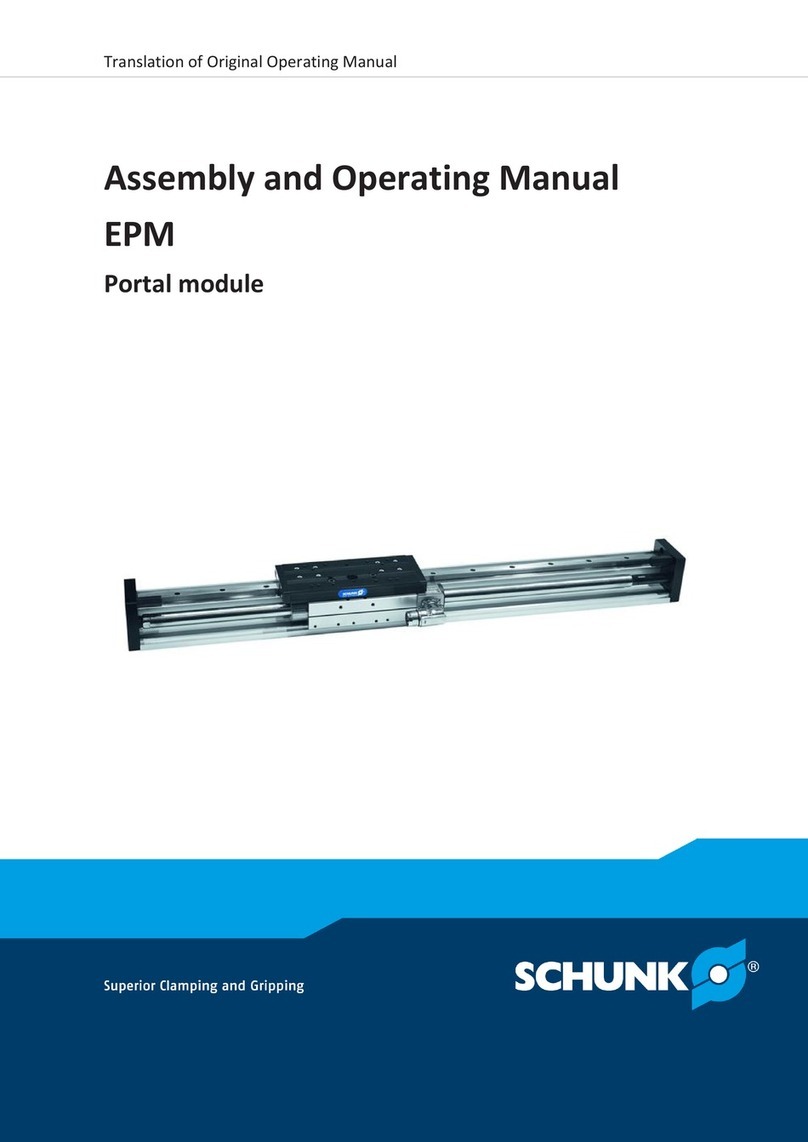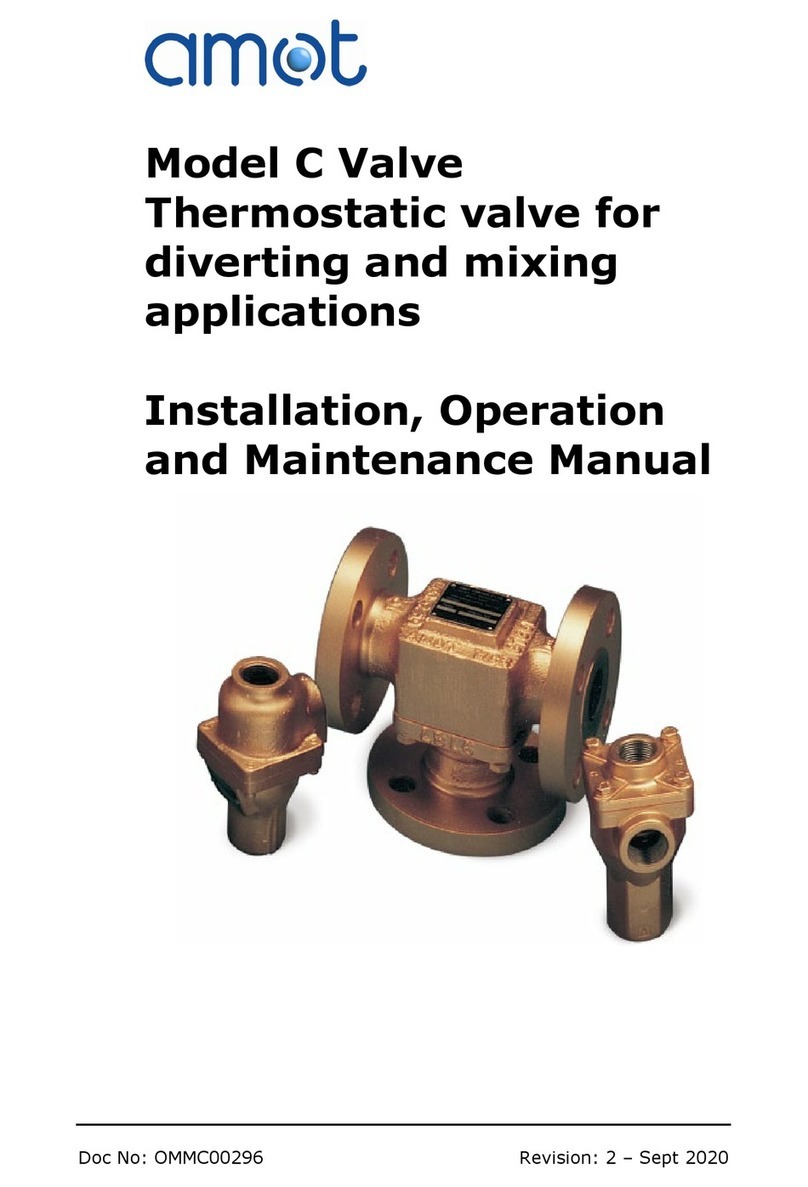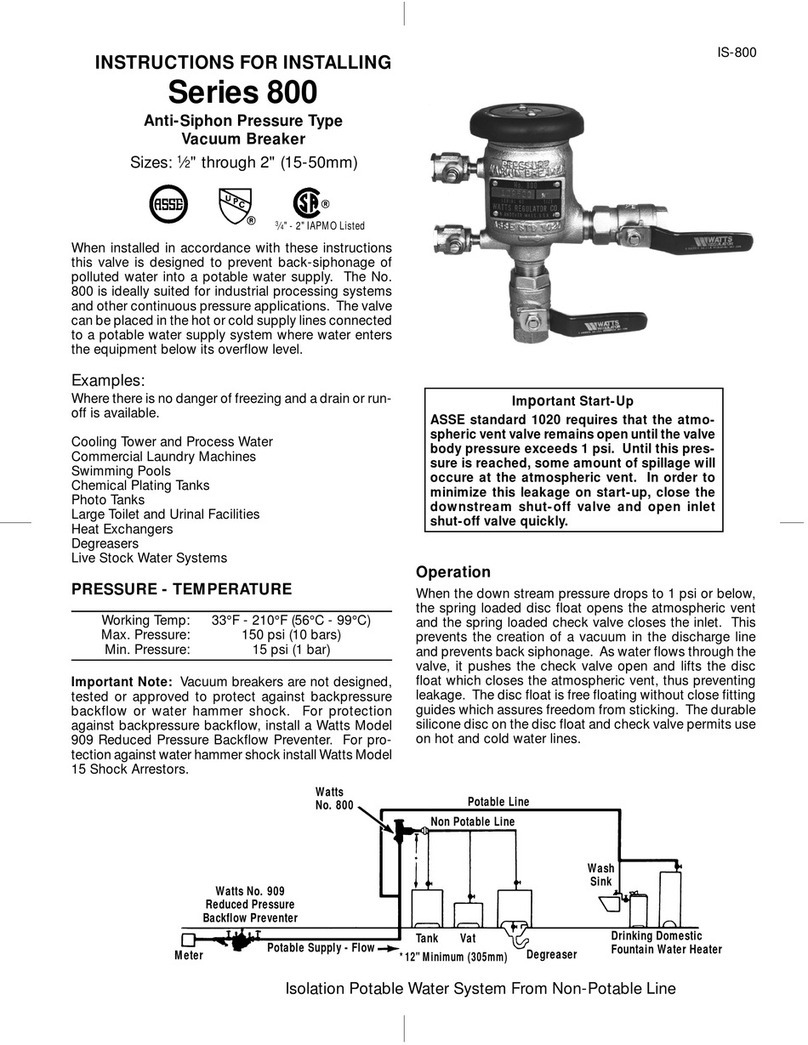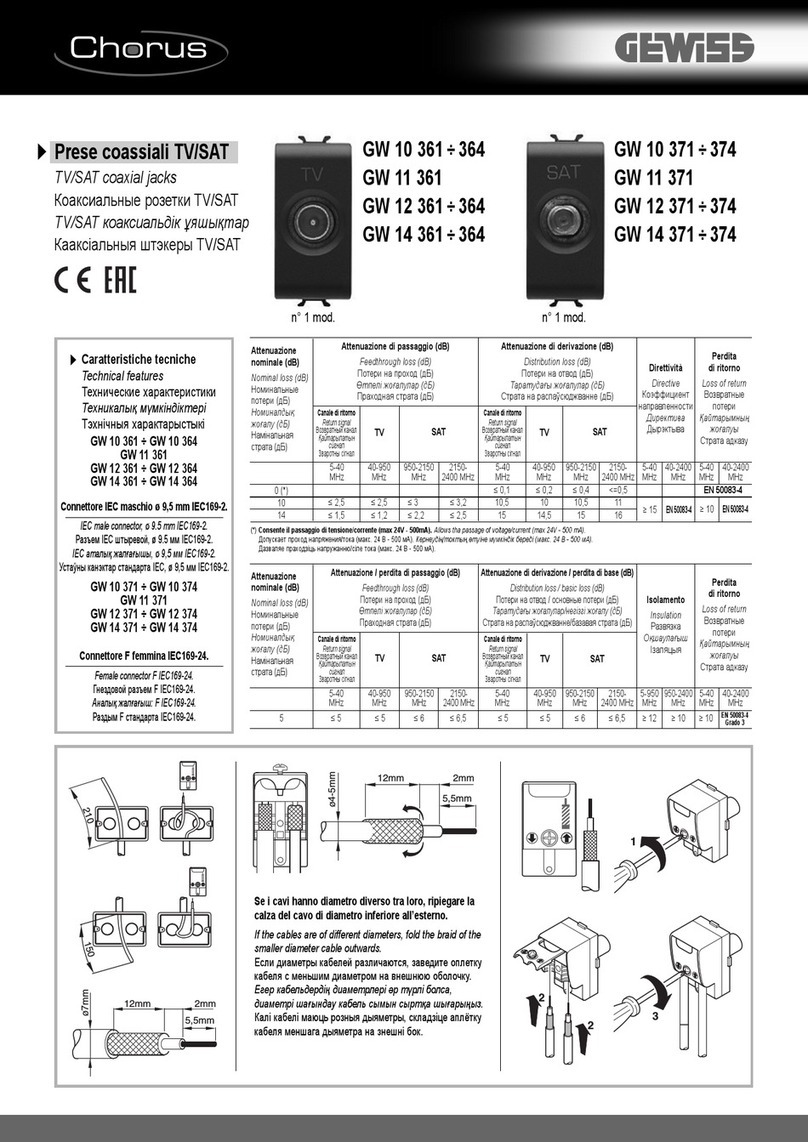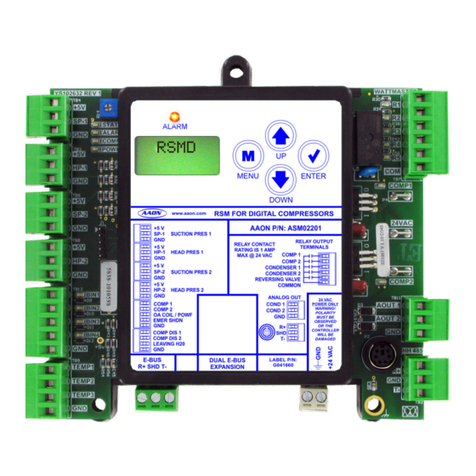Lincoln SKF 85307 User manual

Operating instructions
Model 85307; progressive-line system
Electronic lubrication control unit
Date of issue August 2020
Form number 404771
Version 2

Description
Lubrication controller 85307 is a universal
electronic control unit compatible with
dual-line, single-line and progressive
lubrication systems. Provides flexibility and
control over traditional single-line systems.
Controller digital display quickly identifies
system status with easy-to-identify codes.
Programming of unit requires simple
information allowing operator to focus
on specific utilized system.
Features
• Runs progressive, single-line and
dual-line lubrication systems.
• Timing intervals from 5 seconds to
24 hours.
• Cycle counting.
• 10 V to 30 V operation.
• Short circuit/open circuit detection with
audible warning.
• External fault lamp drive (flash or steady
output).
• Low level reservoir monitoring.
• Two sensor switch inputs.
• Visual and audible fault indication.
• Non-volatile memory.
• Built-in blown fuse indicator.
• 3-digit LED display indicates exact
system status.
• Simple setup procedure.
• Test mode allows testing of all circuits
connected to controller.
• Practical housing with mounting bracket.
Table 1
Specifications
Voltage 10 V
to 30 V
Current drain 150 mA maximum (no load), 70 mA nominal
Pump output 7 A rms. maximum
Lamp output 3 A maximum
Switching Solid state short circuit protected
Fuse 8 A fast blow 0.79 in (20 mm) glass
Connection 14 way MOLEX MINIFIT - JR
Communications RS232 type
Dimensions 2.8 × 5.7 × 1.5 in (70 × 145 × 38 mm) 1)
Weight 0.66 lbs (300 g)
Protection IP54
Temperature range 5 °F to 122 °F (–15 °C to +50 °C)
1) Includes mounting bracket.
Contents
Description. . . . . . . . . . . . . . . . . . . . . . . . . . . . . . . . . . . . . . . . . . . . . . . . . . . . . . . . . . . . . . 3
Features . . . . . . . . . . . . . . . . . . . . . . . . . . . . . . . . . . . . . . . . . . . . . . . . . . . . . . . . . . . . . . . . 3
Specifications . . . . . . . . . . . . . . . . . . . . . . . . . . . . . . . . . . . . . . . . . . . . . . . . . . . . . . . . . . 3
Safety . . . . . . . . . . . . . . . . . . . . . . . . . . . . . . . . . . . . . . . . . . . . . . . . . . . . . . . . . . . . . . . . . . 4
Operational precautions . . . . . . . . . . . . . . . . . . . . . . . . . . . . . . . . . . . . . . . . . . . . . . . . . . . . 4
Explanation of signal words for safety . . . . . . . . . . . . . . . . . . . . . . . . . . . . . . . . . . . . . . . . . 4
Keypad layout . . . . . . . . . . . . . . . . . . . . . . . . . . . . . . . . . . . . . . . . . . . . . . . . . . . . . . . . . . 5
LED code descriptions . . . . . . . . . . . . . . . . . . . . . . . . . . . . . . . . . . . . . . . . . . . . . . . . . . . . 6
Setup mode
Progressive-line system with no monitoring . . . . . . . . . . . . . . . . . . . . . . . . . . . . . . . . . 10
Running system (pump run). . . . . . . . . . . . . . . . . . . . . . . . . . . . . . . . . . . . . . . . . . . . . . . . . 14
Running system (pump pause). . . . . . . . . . . . . . . . . . . . . . . . . . . . . . . . . . . . . . . . . . . . . . . 14
Wiring diagram of progressive-line system without sensors . . . . . . . . . . . . . . . . . . . . . 15
Wiring of pump with solenoid relay switch. . . . . . . . . . . . . . . . . . . . . . . . . . . . . . . . . . . . 15
Setup mode
Progressive-line system with reservoir monitoring, run and pause time only. . . . . . 16
Run mode . . . . . . . . . . . . . . . . . . . . . . . . . . . . . . . . . . . . . . . . . . . . . . . . . . . . . . . . . . . . . . . 21
Running system (pump run). . . . . . . . . . . . . . . . . . . . . . . . . . . . . . . . . . . . . . . . . . . . . . . . . 21
Running system (pump pause). . . . . . . . . . . . . . . . . . . . . . . . . . . . . . . . . . . . . . . . . . . . . . . 21
Setup mode
Progressive-line system with reservoir monitoring using run cycle counter . . . . . . . 22
Run mode . . . . . . . . . . . . . . . . . . . . . . . . . . . . . . . . . . . . . . . . . . . . . . . . . . . . . . . . . . . . . . . 27
Running system (pump run). . . . . . . . . . . . . . . . . . . . . . . . . . . . . . . . . . . . . . . . . . . . . . . . . 27
Running system (pump pause). . . . . . . . . . . . . . . . . . . . . . . . . . . . . . . . . . . . . . . . . . . . . . . 27
Wiring of pump with progressive-line system with sensors . . . . . . . . . . . . . . . . . . . . . . 28
Fault indications . . . . . . . . . . . . . . . . . . . . . . . . . . . . . . . . . . . . . . . . . . . . . . . . . . . . . . . . 29
Warranty . . . . . . . . . . . . . . . . . . . . . . . . . . . . . . . . . . . . . . . . . . . . . . . . . . . . . . . . . . . . . . . 32
2 3

1
2
3
4
5
6
7
8
9
10
11
12
13
14
15
16
17
18
19
20
21
22
23
24
Explanation of signal
words for safety
NOTE
Emphasizes useful hints and
recommendations as well as
information to prevent property damage
and ensure efficient trouble-free
operation.
CAUTION
Indicates a dangerous situation that can
lead to light personal injury if
precautionary measures are ignored.
WARNING
Indicates a dangerous situation that
could lead to death or serious injury if
precautionary measures are ignored.
DANGER
Indicates a dangerous situation that will
lead to death or serious injury if
precautionary measures are ignored.
Safety
Read and carefully observe operating
instructions before unpacking and operating
equipment. Equipment must be operated,
maintained and repaired exclusively by
persons familiar with operating instructions.
Local safety regulations regarding
installation, operation and maintenance
must be followed.
Operate equipment only after safety
instructions and this service manual are
fully understood.
Operational
precautions
User must have total understanding of
controller specifications. Never connect any
other voltage supply other than specified in
manuals contained within.
Operator/owner must ensure installation
or inspections are executed by authorized
personnel who have thoroughly read
operating instruction manual.
Switch machine off before performing any
setup or work on controller. Position
machine so no harm can be caused to any
person should machine be switched on
during setup of controller. Operator or
personnel working on machine must be
advised in the event machine needs to be on
for setup of controller.
Never switch machine on without prior
knowledge of operator/owner or someone
with full knowledge of machines operation.
WARNING
• Never weld on machine while main
switch of machine is on. Ensure main
switch is off and correctly tagged.
Welding on machine can cause
serious damage to controller.
• Do not alter or modify any part
of controller.
• Always mount controller in
suitable area.
• Do not mount controller near an area
with excessive heat.
• Always use correct specified fuse
rating for controller.
• Never exceed voltage rating of
controller.
• Never expose controller to direct
sunlight.
• Never expose controller to water or
other substances.
Fig. 1
Keypad layout
Item Description
1Enter button
2 Run/pause buttton
3 Setup indicator
4 Mounting bracket
5 LED display
6 Cycle indicator
7 Second indicator
8 Minute indicator
9 Hour indicator
10 Select value down or silent buzzer
11 Blown fuse indicator
12 Fuse holder, 8 A
13 Power positive/negative
14 Ignition input/aux power output positive
15 Sensor 1 positive/negative
16 Sensor 2 positive/negative
17 External lamp
18 Reservoir sensor connection
19 Pump motor positive/negative
20 RS 232 connection
21 Reservoir low level status indicator
22 Sensor 2 status indicator
23 Sensor 1 status indicator
24 Pump status indicator
4 5

sec
min
hrs
cyc
SETUP
sec
min
hrs
cyc
SETUP
sec
min
hrs
cyc
SETUP
sec
min
hrs
cyc
SETUP
sec
min
hrs
cyc
SETUP
sec
min
hrs
cyc
SETUP
sec
min
hrs
cyc
SETUP
sec
min
hrs
cyc
SETUP
sec
min
hrs
cyc
SETUP
sec
min
hrs
cyc
SETUP
LED code descriptions
Fig. 2
Fig. 3
Fig. 4
Fig. 5
Fig. 6
Fig. 7
Fig. 8
Fig. 9
Fig. 10
Fig. 11
SLS = single-line system
PLS = progressive-line system
DLS = dual-line system
n – 0 = normally open (sensors)
n – C = normally closed (sensors)
L – S = external lamp steady (continued supply)
L – F = external lamp flashing (pulsed supply)
nFE = non-fatal error (pump continues on low level fault)
r= run time in cycles
P= pause time in seconds, minutes or hours
6 7

sec
min
hrs
cyc
SETUP
sec
min
hrs
cyc
SETUP
sec
min
hrs
cyc
SETUP
sec
min
hrs
cyc
SETUP
sec
min
hrs
cyc
SETUP
sec
min
hrs
cyc
SETUP
sec
min
hrs
cyc
SETUP
sec
min
hrs
cyc
SETUP
sec
min
hrs
cyc
SETUP
sec
min
hrs
cyc
SETUP
Fig. 12
Fig. 13
Fig. 14
Fig. 15
Fig. 16
Fig. 17
Fig. 18
Fig. 19
Fig. 20
Fig. 21
LED code descriptions
F= fault time in seconds, minutes or hours
U= vent time in seconds, minutes or hours
rCC = run cycle counter
YES = confirms program changes
tSt = test mode for checking installed devices
t= time out or dwell time for sensors
FE = fatal errors (pump stops on Low Level Fault)
nO = do not select selection
r= run time in seconds, minutes or hours
.= standby mode
8 9

S
TEP 5
-
- --
8Amp
P2
RES IGN
P1
12V
24V
M
+++
+
-
TX RX
sec
min
hrs
cyc
SETUP
Fuse
PROXY 1
PUMP
PROXY 2
RESERVOIR
RUN
PAUSE
ENTER
85307 Controller
AB C A B
Setup mode
Progressive-line system with no monitoring
Fig. 22
1 To enter setup mode:
Press and hold ENTER while switching on controller
power source.
2 Release ENTER and red LED next to SETUP illuminates.
Green LED next to PUMP flashes. PLS (progressive-line system)
appears in display.
3 Press ENTER to confirm use of progressive-line system
(Fig. 22 A).
4 P (pause) appears in display. Press Δto change time (Fig. 22 B).
LED changes from seconds to minutes to hours. Display indicates
amount of pause time when function is applied.
5 Press ENTER to confirm pause time. In example, pause time of
4 hours is confirmed (Fig. 22 C).
6 R (run) appears in display. Press Δto change time (Fig. 23 A).
LED changes from seconds to minutes to hours. Display indicates
amount of run time.
7 Press ENTER to confirm run time.
In example, run time of 30 minutes is confirmed (Fig. 23 B).
Fig. 23
10 11

AB C A B
8 With run time confirmed, select Δor ∇to verify sensor use
(Fig. 24 A). Press Δor ∇until nO appears in display.
Green LED flashes next to PROXY 1 indicating sensor
part of setup procedure.
9 Press ENTER to select nO and PROXY 1 will not be setup
(Fig. 24 B).
10 Press ENTER again on setup procedure to omit PROXY 2 and
green LED on RESERVOIR begins to flash.
11 Push ENTER to confirm nO for low level monitoring (Fig. 24 C).
12 L - F (lamp flashing) displays. This option is used with external
warning lamp. Typically, if monitoring is installed, this function is
used. Press Δand change status from L - F (lamp flashing) to
L - S (lamp static). L - F is a pulsed output supply and L -S is a
constant output supply.
13 With no monitoring used, press ENTER with either choice
selected to move to next part of programming (Fig. 25 A).
14 tSt (test mode) appears in display indicating test mode of setup
procedure. Press Δfor pump to start turning (Fig. 25 B). Correct
pump from turning in wrong direction by changing polarity of
wiring.
15 If all is correct, turn off power supply to controller.
Fig. 24 Fig. 25
NOTE
tSt must appear on display before switching off power to unit.
System does not save changes if power to unit is turned off
during any part of programming. tSt must appear on display for
changes to be confirmed.
12 13

S
TEP 5
-
-- -
8Amp
P2
RES IGN
P1
12V
24V
M
++
+
+-
-
+
1
2
1)
2)
-
Amp
8
P2
RES
IGN
P1
M
-- - ++
+12 V
24 V
1
2
3
4
5
1)
2)
Fig. 26 Running system (pump run)
Run (r) time displays when controller is switched on. Time appears
from actual time set and counts down to zero. Green LED indicates
minutes (Fig. 26). Green LED next to PUMP flashes to indicate pump
is turning or pumping.
Fig. 27 Running system (pump pause)
Controller enters pause time when required run time is reached.
Pause (P) time counts down from original setup time to zero and
then resumes run time (Fig. 27). Green LED is steady next to PUMP
indicating pump is on but not turning while in pause mode.
Item Description
1 Motor
2 Ignition
1) Top row represents front of controller.
2) Bottom row represents back of controller.
NOTE: If motor amp draw exceeds the maximum specification († Table 1, page 3), solenoid relay switch (69897S) must be used. Refer to († Diagram 2).
Item Description
1Fuse, 7.5A
2Solenoid relay switch
3 Motor
4 Vent valve solenoid (NO)
5 Power supply, 12 or 24V
Diagram 1
Wiring diagram of progressive-line system without sensors
Diagram 2
Wiring of pump with solenoid relay switch
1) Top row represents front of controller.
2) Bottom row represents back of controller.
14 15

STEP 9STEP 9
A B
STEP 9 STEP 11
A B
Fig. 28
Setup mode
Progressive-line system with reservoir monitoring, run and pause time only
1 Refer to steps 1-6 on pages 10 through 11.
2 Select Δor ∇until YES appears in display to verify use of sensor
(Fig. 28 A). Green LED flashes next to PROXY 1 indicating sensor
part of setup procedure.
3 Press ENTER to select YES and PROXY 1 enters setup procedure.
4 t (time out) appears in display indicating alarm will activate if
sensor does not send signal to controller within set time. This
function is used when flow proximity sensor is installed on feeder.
Within feeder, piston activates sensor and sends signal to
controller. Controller resets time out and starts counting down
to start monitoring process. This function continues to work while
in RUN mode. Set time out greater than cycle time of specific
feeder. This depends on type of pump being used.
Press Δto increase time out to desired setting.
5 Press ENTER to confirm. In example, time out of 5 seconds is
confirmed (Fig. 28 B).
Fig. 29
6 n-O (normally open) appears in display. Indicates if sensor is
normally open or normally closed.
7 Press Δto choose between n-O or n-C.
8 Press ENTER to confirm choice (Fig. 29 A).
9 nO appears in display. Green LED on PROXY 2 illuminates.
If 2nd proxy is necessary, proceed by pushing Δ.
10 Press ENTER to confirm and proceed setup for PROXY 1.
11 For one sensor, press Δuntil nO appears in display.
12 Press ENTER to confirm (Fig. 29 B).
16 17

STEP 9 STEP 13
AB C
STEP 9 STEP 15
A B
Fig. 30
13 nO appears in display. Green LED on reservoir illuminates
(Fig. 30 A). In setup procedure, there is an option of selecting low
level detection.If low level detection is not required, push Δand
select nO.
14 Press ENTER to confirm.
15 For this example, press Δuntil YES appears in display.
16 Press ENTER to confirm (Fig. 30 B).
17 n-O (normally open) appears in display.This indicates sensor is
normally open or normally closed. Press Δto choose between
n-O or n-C.
18 Press ENTER to confirm choice (Fig. 30 C).
NOTE
10-second delay occurs on startup when using low level sensor
to ensure paddle assembly is in correct position.
Sensor activates on low level after 10 seconds. Low level
warning displays when unit reaches pause status.
Fig. 31
19 FE (fatal error) or nFE (nonfatal error) appears in display.
Option FE (fatal error) is used to stop pump on low level warning.
Typically used on pumps with reservoir capacities from 0.26 to
2.6 gal (1 to 10 l). It is preferred to stop pump at low level to
maintain layer of grease above pump element area thereby
not allowing air pockets to form around pump element when
filling up reservoir. Option nFE (nonfatal error) is recommended
on larger pump reservoirs with substantial distance from pump
tube to bottom of reservoir.
20Select choice and press ENTER (Fig. 31 A).
21 L - F (lamp flashing) displays. This option is used with external
warning lamp. Typically, if monitoring is installed, this function is
used. Press Δand change status from L - F (lamp flashing) to
L - S (lamp static). L - F is a pulsed output supply and L -S is a
constant output supply.
22 Press ENTER with either choice selected to proceed to next part
of programming (Fig. 31 B).
18 19

Fig. 33
Fig. 34
Fig. 35
Run mode
Unit proceeds in run (r) mode after power is terminated on unit and
then switched on again. All devices selected display.
Running system (pump run)
Run (r) time displays when controller is switched on. Time appears
from actual time set and counts down to zero. Green LED indicates
minutes (Fig. 34). Green LED next to PUMP flashes to indicate pump
is turning or pumping.
Running system (pump pause)
Controller goes into pause time when required run time is reached.
Pause (P) time counts down from original setup time to zero and
then resumes run time (Fig. 35). Green LED next to PUMP is steady
to indicate pump is there by not turning while in pause mode.
Fig. 32
23 tSt (test mode) appears in display. Press Δfor pump to start
turning (Fig. 32). Correct pump from turning in wrong direction
by changing polarity of wiring. Check other sensors by energizing
them manually and observing if green LED illuminates. If LED
does not illuminate, a problem exists with wiring or setup
procedure.
24 If all is correct, turn off power supply to controller
NOTE
tSt must appear on display before switching off power to unit.
System does not save changes if power to unit is turned off
during any part of programming. tSt must appear on display for
changes to be confirmed.
20 21

STEP 9 STEP 9
A B
STEP 9STEP 9STEP 9
AB C
Fig. 36
Setup mode
Progressive-line system with reservoir monitoring using run cycle counter
1 Refer to steps 1–5 on pages 10.
2 To use rCC (run cycle counter), select ∇(Fig. 36 A).
If Δis pressed by accident, continue to press Δuntil rCC displays.
During run cycle, controller looks for signal from proximity
sensor normally fitted to feeder system ensuring complete
machine is lubricated adequately.
Some calculation is necessary to calculate cycles required
through specific feeder system used.
3 t (time out ) appears in display indicating alarm will activate if
sensor does not send signal to controller within set time. This
function is used when flow proximity sensor is installed on feeder.
Piston activates sensor within feeder and sends signal to
controller. Controller resets time out and starts counting down to
start monitoring process. This function continues to work while in
run cycle mode. It is important to set time out greater than cycle
time of specific feeder. This also depends on pump being used.
Press Δto increase time out to desired setting.
4 Press ENTER to confirm (Fig. 36 B).
In example, time out of 45 seconds is confirmed.
5 n-O (normally open) appears in display. This indicates if sensor is
normally open or normally closed. Press Δto choose between
n-O or n-C.
6 Press ENTER to confirm choice (Fig. 37 A).
7 Press ENTER again to confirm use of run cycle counter
(Fig. 37 B).
8 Press Δto increase number of cycles required (Fig. 37 C).
Remember 1 cycle represents complete cycle of feeder.
For example, should 6 port feeder be used, 1 cycle indicates
feeder has lubricated all 6 points. 1 cycle is not equal to 1 minute
run time.The larger the feeder, the longer it takes to reach 1 cycle
9 After selecting amount of cycles, press ENTER to confirm.
Fig. 37
22 23

STEP 9STEP 9
A B
STEP 9STEP 9
STEP 13
AB C
10 nO appears in display. Green LED on PROXY 2 illuminates. Should
2nd proxy be necessary, proceed by pushing Δ.
11 Press ENTER to confirm and proceed setup for PROXY 1.
12 When one sensor is used, press Δuntil nO appears in display.
13 Press ENTER to confirm (Fig. 38 A).
14 nO appears again in display. Green LED on RESERVOIR
illuminates. Setup procedure allows selection of
low level detection.
Push Δand select nO if low level detection is not required.
15 Press ENTER to confirm. For this example, select low level option
by pressing Δuntil YES appears in display.
16 Press ENTER to confirm (Fig. 38 B).
17 n-O (normally open) displays indicating if sensor is normally open
or normally closed. Press Δto choose between n-O or n-C.
18 Press ENTER to confirm choice (Fig. 39 A).
19 FE (fatal error) or nFE (nonfatal error) appears in display.
Option FE (fatal error) is used to stop pump on low level warning.
Typically used on pumps with reservoir capacities from 0.26 to
2.6 gal (1 to 10 l). It is preferred to stop pump at low level to
maintain layer of grease above pump element area thereby
not allowing air pockets to form around pump element when
filling up reservoir (Fig. 39 B).
Option nFE (nonfatal error) is recommended on larger pump
reservoirs with substantial distance from pump tube to bottom
of reservoir (Fig. 39 C).
20Press Δto select choice and press ENTER to confirm.
Fig. 38 Fig. 39
NOTE
10-second delay occurs on startup when using low level sensor
to ensure paddle assembly is in correct position.
Sensor activates on low level after 10 seconds. Low level
warning displays when unit reaches pause status.
24 25

AB C
21 L - F (lamp flashing) displays (Fig. 40 A). This option is used with
external warning lamp, typically used if monitoring is installed.
Press Δand change status from L - F (lamp flashing) to
L - S (lamp static) (Fig. 40 B). L - F is a pulsed output supply and
L -S is a constant output supply.
22 Select option and press ENTER to proceed to next part of
programming.
23 tSt (test mode) appears in display. Pump starts turning. Correct
pump from turning in wrong direction by changing polarity of
wiring. Check other sensors by energizing them manually and
observing if green LED illuminates. If LED does not illuminate, a
problem exists with wiring or setup procedure.
24 If all is correct, turn off power supply to controller
Fig. 40
NOTE
tSt must appear on display before switching off power to unit.
System does not save changes if power to unit is turned off
during any part of programming. tSt must appear on display for
changes to be confirmed.
Fig. 41
Fig. 42
Fig. 43
Run mode
Unit proceeds in run (r) mode after power is terminated on unit and
then switched on again. All devices selected display. After each cycle
received, amount decreases by 1 until all cycles have been reached
and unit proceeds to pause time.
Running system (pump run)
When controller is switched on, run cycle counter (rCC) appears in
display. Counter appears from actual counts set and counts down to
zero. Green LED indicates run cycle counter. Green LED on PUMP
flashes indicating pump is turning or pumping.
Running system (pump pause)
Controller goes into pause time when required cycle count is
reached. Pause (P) time counts down from original setup time to
zero and then resumes cycle count. Green LED next to PUMP is
steady to indicate pump is there by not turning while in pause mode.
26 27

-
-
-
-
Amp
8
P2
RES
IGN
P1
V
12
24V
M
+
+
+
1
2
3
4
5
6
1)
2)
1
2
3
4
5
6
7
8
Diagram 3
Wiring of pump with progressive-line system with sensors
Item Description
1 Motor
2Power switch
3 Power supply
4 Proxy 1
5 External warning lamp
6 Low level sensor
Fig. 44
Fault indications
NOTE
Unit must perform one complete cycle of run and pause to
cancel existing fault out of memory for fault to reset. Unit is
designed to memorize total time of any specific fault. Unit
must run one complete cycle to function correctly without
same fault occurring.
Item Description
1 Press RUN/PAUSE to reset faults.
2 Fault indication – counts up from
seconds to minutes to hours indicating
how long fault has been active.
3 Press ∇button to silence buzzer.
4 Blown fuse indication – replace with
8A fuse.
5Fuse holder – use 8 A fuse.
6 Low level fault – possible cause,
reservoir empty.
7PROXY 1 fault – either blockage in
system or faulty sensor.
8PUMP fault – either short circuit or wires
are disconnected.
1) Top row represents front of controller.
2) Bottom row represents back of controller.
28 29

This page left intentionally blank. This page left intentionally blank.
30 31

skf.com | lincolnindustrial.com
® SKF and Lincoln are registered trademarks of the SKF Group.
© SKF Group 2020
The contents of this publication are the copyright of the publisher and may not be reproduced (even
extracts) unless prior written permission is granted. Every care has been taken to ensure the accuracy
of the information contained in this publication but no liability can be accepted for any loss or damage
whether direct, indirect or consequential arising out of the use of the information contained herein.
August 2020 · Form 404771Version 2
Warranty
The instructions do not contain any information on the warranty.
This can be found in the General Conditions of Sales, available at:
www.lincolnindustrial.com/technicalservice or www.skf.com/lubrication.
Table of contents
Other Lincoln Control Unit manuals
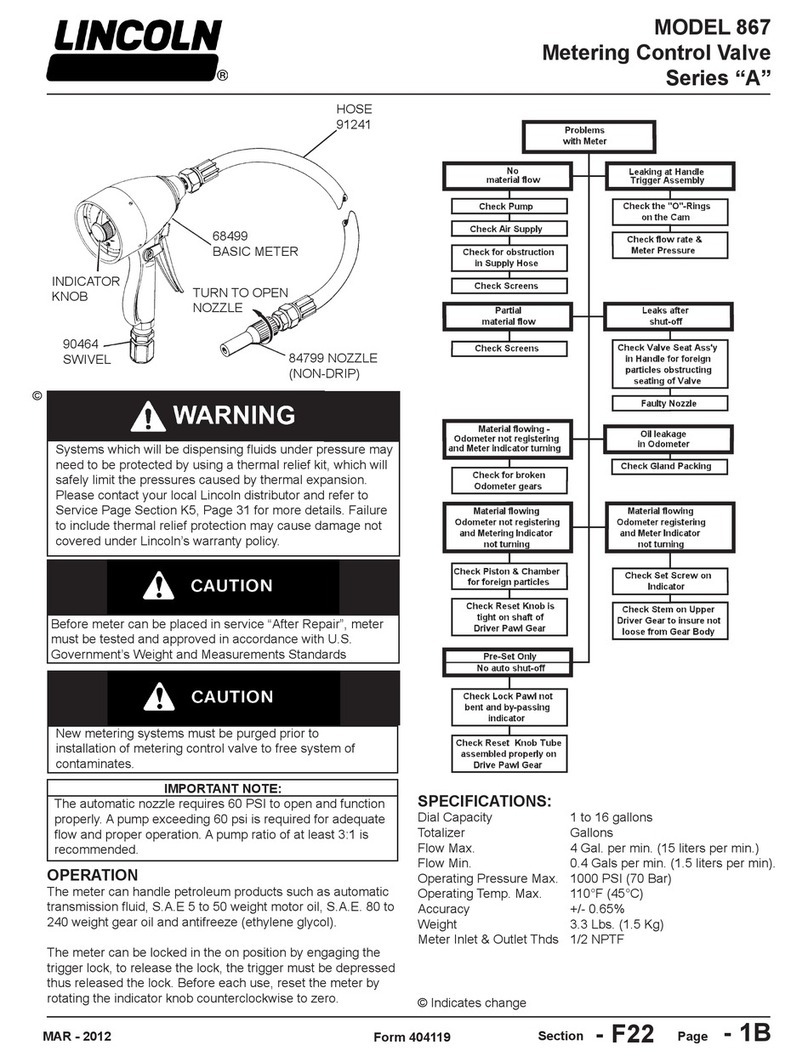
Lincoln
Lincoln A Series User manual
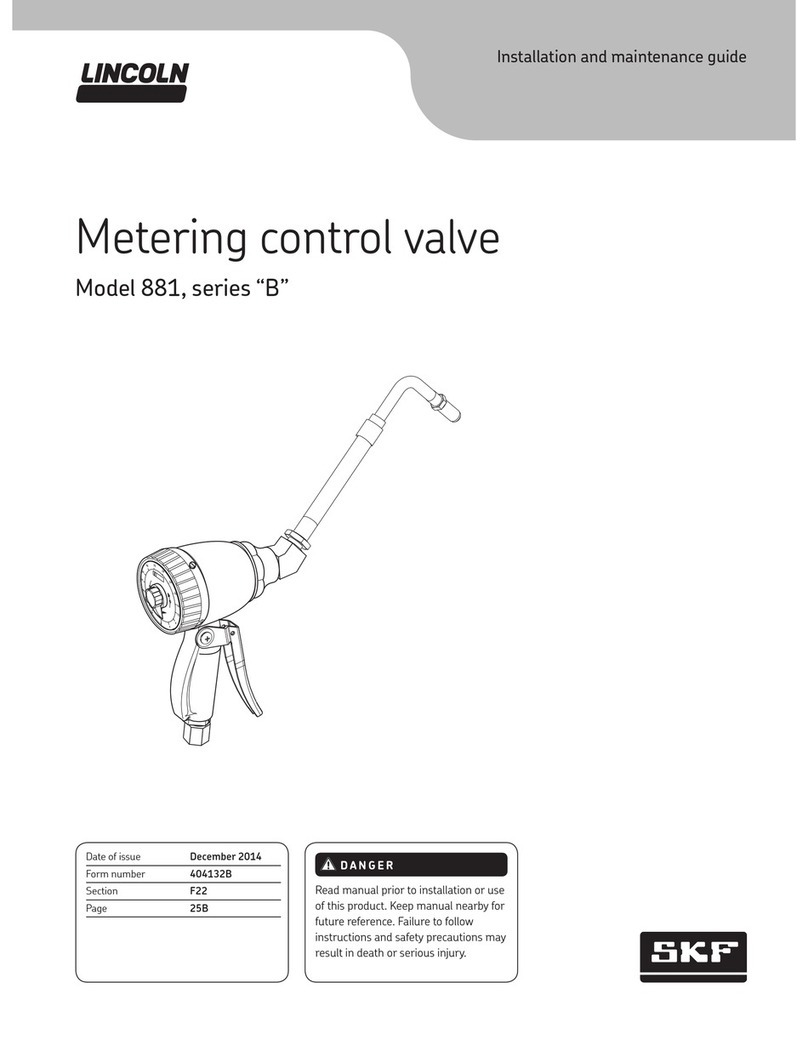
Lincoln
Lincoln 881 Product manual
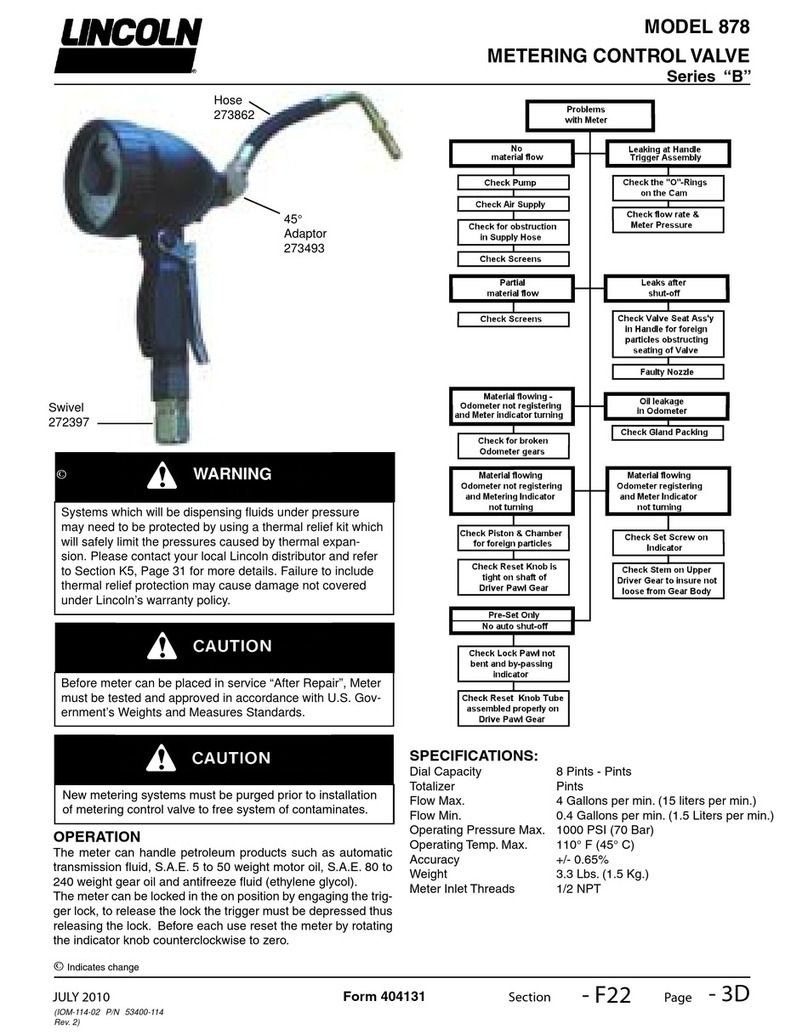
Lincoln
Lincoln B Series User manual
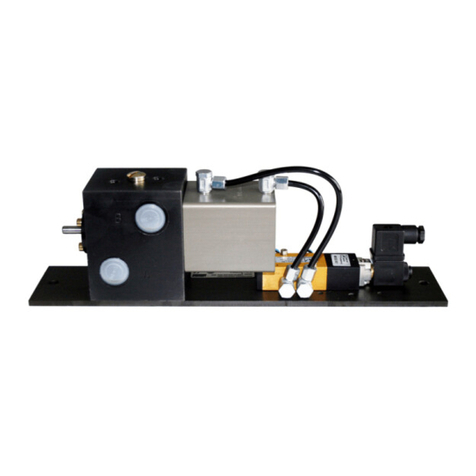
Lincoln
Lincoln MP2 User manual
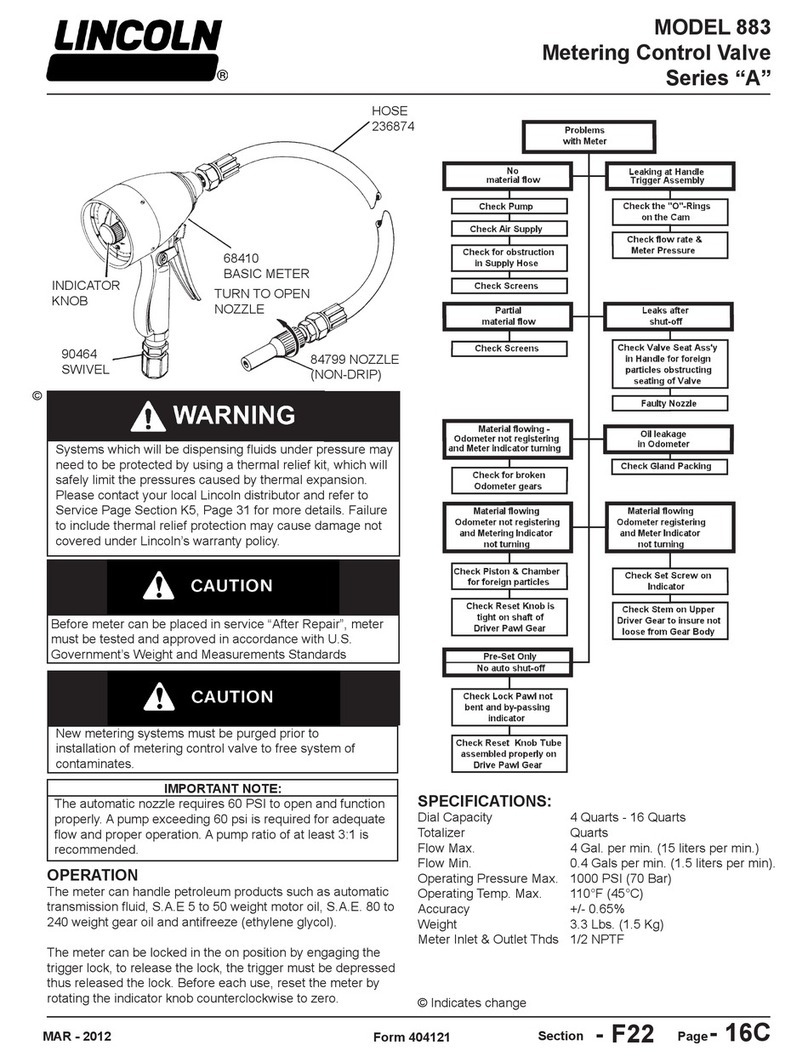
Lincoln
Lincoln A Series User manual

Lincoln
Lincoln A Series User manual

Lincoln
Lincoln SKF IG502-2-E User manual
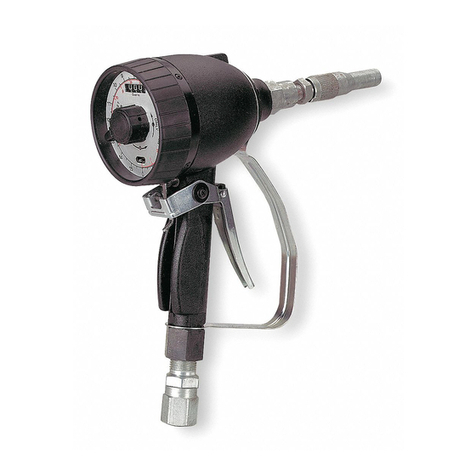
Lincoln
Lincoln 3866 User manual

Lincoln
Lincoln 85660 User manual

Lincoln
Lincoln Quicklub 236-13857-1 User manual
